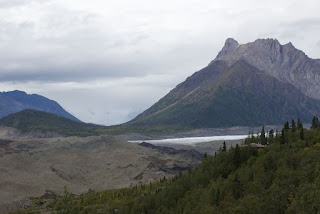At the end of the McCarthy road and the confluence of the Kennecott and Root Glaciers lies the remains of one of the richest copper finds in the world. The Kennecott copper mine which was shutdown in November of 1938, is a must-see for those who love the history of mineral prospecting, mining, and the hay day of US industry.
 |
| This rock glacier is 90 percent rock and 10 percent ice... one of only two such glaciers in the world. |
 |
| Kennicott Lodge |
I took a two and a half hour tour of the facility where our tour group climbed to the top of the separation/refining building and down through its bowels. Our tour guide explained the refining process to us and how life was during that time. I have always been infatuated with how things are made. The processes, and equipment that are used. What challenges and risks the people faced at work, in in their community, and how they over came them. It is a snapshot of the progress of man or lack there of, depending on how you look at it.
 |
| Ammonia extraction building. |
 |
| Kennicott power house as seen from separation building. |
 |
| Separation building and mine support complex |
 |
| Kennicott hospital. This hospital was state-of-the art when built and had the first X-ray machine in Alaska. |
 |
| Remains of Kennicott maintenance shop |
David, Thank you for the McCarthy/Kennicott text and photos. We got as far as Chitina, a few days after your tour, but didn't have a vehicle to handle the road conditions to McCarthy. I enjoyed your discussion of the history and your photos gave me a nice view of the mine complex. Al Perry
ReplyDelete